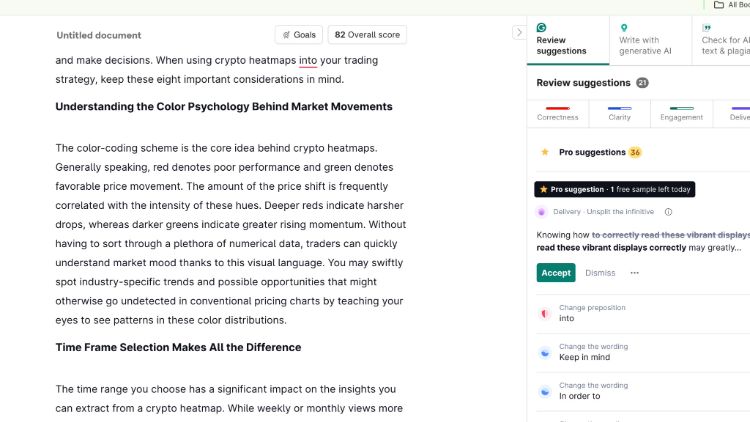Heatmaps of cryptocurrencies have grown to be quite useful resources for traders and investors trying to understand the ever-changing digital asset market. These visual representations provide an overview of market performance by using color gradients to show price fluctuations across many cryptocurrencies at once.
Knowing how to correctly read these vibrant displays may greatly improve your ability to analyze the market and make decisions. When using crypto heatmap into your trading strategy, keep these eight important considerations in mind.
1. Understanding the Color Psychology Behind Market Movements
The color-coding scheme is the core idea behind crypto heatmaps. Generally speaking, red denotes poor performance and green denotes favorable price movement. The amount of the price shift is frequently correlated with the intensity of these hues. Deeper reds indicate harsher drops, whereas darker greens indicate greater rising momentum. Without having to sort through a plethora of numerical data, traders can quickly understand market mood thanks to this visual language. You may swiftly spot industry-specific trends and possible opportunities that might otherwise go undetected in conventional pricing charts by teaching your eyes to see patterns in these color distributions.
2. Time Frame Selection Makes All the Difference
The time range you choose has a significant impact on the insights you can extract from a crypto heatmap. While weekly or monthly views more effectively illustrate long-term patterns and market cycles, short-term heatmaps displaying hourly or daily movements may highlight transient swings and instant trading opportunities. Keep in mind that when seen through a 7-day lens, patterns that are obvious in a 24-hour heatmap may vanish entirely. In order to discern between short-term noise and significant long-term moves, successful traders frequently examine a variety of time horizons. By providing context, this multi-timeframe method helps avoid impulsive trading decisions that may otherwise result from quick responses to transient market fluctuations.
3. Size Matters: Understanding Market Capitalization Weighting
The majority of advanced crypto heatmaps modify the block size of each cryptocurrency based on its market value. Traders may better grasp which assets are moving and their relative importance in the market as a whole with the aid of this visual weighting. In comparison to a little movement in Bitcoin, a minor cryptocurrency may flash brilliant green with a 20% increase, but its effect on the larger market is still negligible. Consider both block size and color intensity while examining market patterns. Larger blocks are especially crucial indications for determining market direction since their movement frequently indicates massive money flows that have the potential to affect the whole ecosystem.
4. Sector Analysis Reveals Hidden Patterns
Cryptocurrencies such as DeFi, NFTs, layer-1 protocols, or privacy coins are frequently grouped by sectors or categories in contemporary crypto heatmaps. This structure enables you to spot industry-specific patterns that you would overlook when examining the market as a whole. This sector split may point to a change in investor preference rather than a general market trend if DeFi tokens are all displaying green but gaming tokens are becoming red. Before they become evident in individual price charts, these sector fluctuations typically provide early indications of capital rotation. You may stay ahead of more general market realignments by keeping an eye on how various industries perform in comparison to one another.
5. Correlation Insights Beyond Single Assets
Heatmaps are excellent at displaying correlations between several cryptocurrencies, highlighting which assets move independently and which ones often move in tandem. You may notice a sea of red or green everywhere during market-wide occurrences, which indicates a significant connection. Certain assets or sectors may deviate from the norm during more complex times. Strategies for diversifying a portfolio can greatly benefit from these correlation patterns. While assets that have a significant positive connection with market leaders may increase profits during optimistic periods, those that regularly move independently of big cryptocurrencies may offer hedging value during market downturns.
6. Volume Indicators Add Crucial Context
Advanced crypto heatmaps, which usually use bubble size or numerical overlays, combine price information with trade volume data. This extra factor aids in differentiating between potentially deceptive “thin” moves that occur on low volume and real price changes supported by substantial trading activity. Stronger confidence and a higher chance of the movement continuing are typically indicated by a sharp price shift and abnormally high volume. On the other hand, price changes that take place on below-average volume could not last. This volume background should always be taken into account when evaluating heatmap colors in order to evaluate the durability of any pattern that is seen.
7. Volatility Recognition for Risk Assessment
A crypto heatmap’s color distribution provides a rapid visual evaluation of market volatility. An extremely volatile market with notable price divergence between assets is usually indicated by a heatmap with stark color contrasts, such as deep reds and brilliant greens. On the other hand, a map with a lot of neutral hues indicates horizontal movement and little volatility. Extreme volatility may portend an impending trend reversal, while abnormally low volatility may suggest accumulation before a noteworthy breakout. These volatility patterns frequently precede important market movements. Traders can modify position sizing and risk management tactics in accordance with these volatility characteristics.
8. Historical Comparison Provides Perspective
Comparing recent trends with past instances yields the most meaningful heatmap analysis. Reviewing heatmaps from prior market cycles is possible on many platforms, which aids in finding parallels to earlier situations. Has this particular distribution pattern of red and green ever happened before? What happened next, if? Even though history is seldom perfectly repeated, identifiable trends frequently correspond with past market trends. By situating current moves within the framework of typical market cycles, this historical view helps to moderate emotional reactions. Developing a mental library of heatmap patterns and the market movements that follow might help you become more methodical and knowledgeable while trading cryptocurrencies.
Conclusion
When examining crypto heatmaps, you can turn these vibrant displays from simple visual attractions into effective analytical tools by bearing these eight things in mind. Heatmaps are useful for summarizing complicated market data, but their real worth comes from the insights they offer when carefully analyzed, taking into account factors like time period, market capitalization, sector dynamics, correlation, volume, volatility, and historical context.


